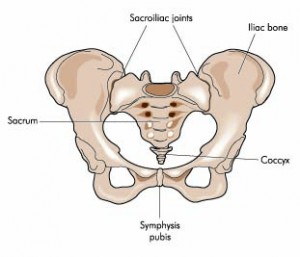According to the journal The Physician and Sportsmedicine, sacroiliac joint dysfunction is “a treatable diagnosis for the millions of individuals suffering from acute and chronic low back pain.” In fact, it is one of the more common causes of mechanical low back pain.
Puzzled by what the sacroiliac joint is and how it can cause pain? Read on to learn more.
What is the sacroiliac joint?
It’s the place where the sacrum and the iliac bones join.
Composed of five vertebrae, the sacrum is located at the base of your spine. On either side of the sacrum are the iliac bones — the two large bones that make up your pelvis.
What are the symptoms of sacroiliac joint dysfunction?
- Hip pain
- Improvement of pain when lying down
- Pain in the lower back, usually only on one side
- Discomfort with bending over or standing after sitting for long periods
Pain may be worse when riding in a car, bearing weight on the affected side, or performing the Valsalva Maneuver (attempting to forcibly exhale while keeping the mouth and nose closed).
What causes sacroiliac joint pain?
 caused by:
caused by:- infection
- trauma or injury
- inflammatory disease
- stress fractures resulting from repetitive activity or overuse
Schedule a phone consultation with an expert therapist to learn more about treating chronic pain naturally.
What are the risk factors for sacroiliac joint dysfunction?
- Scoliosis
- Pregnancy
- Gait abnormalities
- Leg length discrepancy
- Spinal fusion to the sacrum
- Prolonged vigorous exercise
References
Related Content:
Chronic Pain
- Patient Story: Overcoming Chronic Pain After Multiple Traumas
- Adhesions: The Hidden Cause of Chronic Pain (Infographic)
- Post-surgical Pain and Adhesions
- Anti-Inflammatories and Reducing Inflammation Naturally
- Migraines/Chronic Headaches
- Do I Have Mechanical Migraines?
- Myofascial Pain
- How Does Clear Passage® Therapy Compare to Myofascial Release and Visceral Mobilization?
- Myofascial Pain Syndrome and Fibromyalgia: What Is the Difference?
- Sacroiliac Joint Pain



